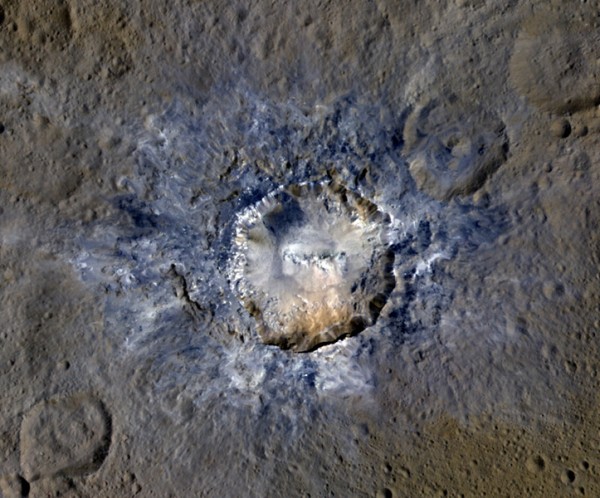By Ana Verayo, | April 21, 2016

Ceres' Haulani Crater, with a diameter of 21 miles (34 kilometers), shows evidence of landslides from its crater rim.
A mysteriously bright crater found on the surface of dwarf planet Ceres was captured in this latest image taken by NASA's Dawn spacercraft from a distance of 240 miles away. What makes this stunning image unique is not only the crater's unprecedented detail but it somehow resembles a giant stop sign.
Like Us on Facebook
The Haulani Crater is zoomed in for a closer look, taken by the NASA probe which is marked by eight angled sides resembling a roughly shaped octagon, measured around 21 miles across. Scientists consider this feature as highly unusual since natural features on planetary bodies are either rounded or curved and almost, never angular.
Mission scientists then proceeded to assemble a false color image of this crater, to examine and investigate the materials found inside this odd feature. Younger crater material can be seen in blue in this new image.
According to Martin Hoffmann of the Max Planck Institute for Solar System Research, the Haulani crater exhibits the expected features of a newly formed, fresh impact on the surface of Ceres. The crater floor is also devoid of any impacts which reveals a stark contrast in color compared to the other areas of the surface.
Apart from this curious crater, the Dawn spacecraft's mission is also to observe several other features on the surface of Ceres, including the six mile wide Oxo Crater where material was found to creep inside, rolling off the edges and on the ground below. Recent data from observations reveal a different mineral composition in this region, unlike any other area found on the dwarf planet.
According to Dawn mission scientist, Chris Russell of the University of California, Los Angeles, Little Oxo holds the key to the better understanding of the upper crust of Ceres and its overall composition. Further investigation of these mysterious bright lights found inside the Oxo Crater is now revealing clues how these distinct features were formed.
To date, this 240 mile altitude of the Dawn spacecraft has been the closest distance from the surface of the dwarf planet, to conduct observations. This closest approach of Ceres also revealed stunning details of the Dantu Crater that bears similar resemblance to the Tycho crater of the Earth's moon.
Mission scientists believe that the straight line bordering the Haulani Crater could be the result of geological fault lines based on stress related patterns, forming an odd octagon shape.
Ceres is located in the main asteroid belt between Mars and Jupiter where Dawn arrived at the dwarf planet last March 2015 where it spotted mysterious, bright spots that pockmark some craters on its surface, as scientists believe that they are made from reflective salts.
-
Use of Coronavirus Pandemic Drones Raises Privacy Concerns: Drones Spread Fear, Local Officials Say

-
Coronavirus Hampers The Delivery Of Lockheed Martin F-35 Stealth Fighters For 2020

-
Instagram Speeds Up Plans to Add Account Memorialization Feature Due to COVID-19 Deaths

-
NASA: Perseverance Plans to Bring 'Mars Rock' to Earth in 2031

-
600 Dead And 3,000 In The Hospital as Iranians Believed Drinking High-Concentrations of Alcohol Can Cure The Coronavirus

-
600 Dead And 3,000 In The Hospital as Iranians Believed Drinking High-Concentrations of Alcohol Can Cure The Coronavirus

-
COVID-19: Doctors, Nurses Use Virtual Reality to Learn New Skills in Treating Coronavirus Patients







